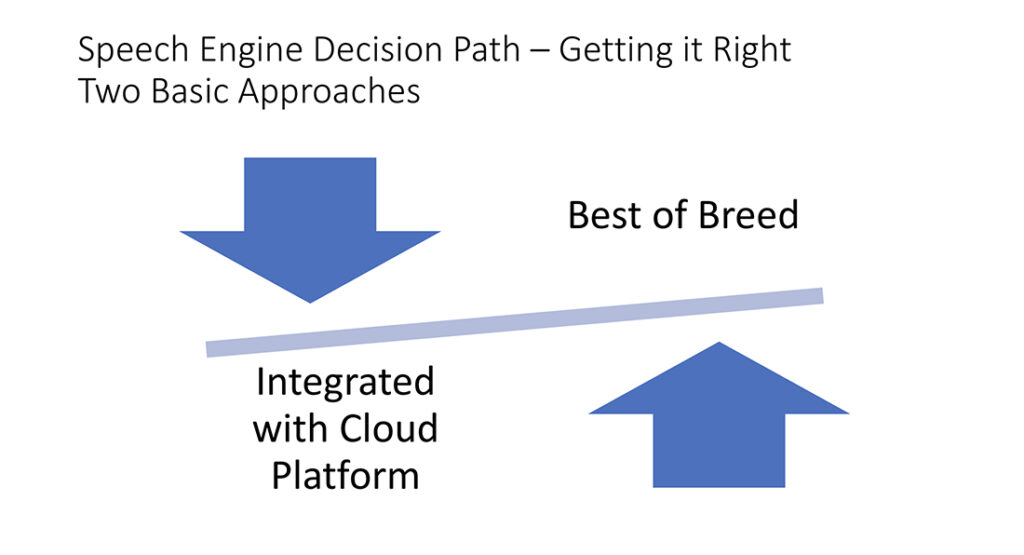When adding AI-enabled speech technology applications, IT leaders have a choice of strategies: invest in best-of-breed tools from a specialized vendor or capitalize on the solutions integrated into a cloud provider’s platform.
“Speech tech is not a new field, but it is advancing quickly with new artificial intelligence applications, especially with speech recognition,” said Jon Arnold, principal, J Arnold & Associates. “In fact, conversational AI is one of the trends for 2022, and we are continuing to learn what’s possible with AI.”
Arnold provided his insights at a recent Enterprise Connect webinar, “Build High Performing Voice Experiences with Best of Breed Software,” hosted by Edward Miller, founder, and CEO, LumenVox, and Eric Krapf, general manager, Enterprise Connect.
“When looking for an AI-enabled speech technology solution, cost, accuracy, and speed are critical,” said Arnold. “So, you need to know how to compare the offerings to identify the best fit for your organization.
Noting that the speech tech field is booming, Arnold said new use cases are emerging. “Traditionally, speech recognition tools had straightforward applications like voice transcription and translation,” he said. “Now there are new use cases for converting speech into text and searchable data. That sets the stage for innovation.”

Miller added that conversational AI applications are growing quickly. “The output of the speech engine can generate data that can be mined in real-time and in large batches to make quick decisions, understand trends, and provide feedback so the engine can be better in the future.”
When considering speech tech, Miller said it’s important to look beyond the AI-enabled application. “You want to support the full user journey, not just a specific case,” he said.
“You also want to be sure the engineering goes deeply into the solution to deliver carrier-grade systems. You can’t have any jitter or dropouts in voice, so quality of service (QOS) is critically important to the ability to deliver voice processing in real-time.”
Like other technology investments, speech applications can be solution specific or take an all-in-one approach, according to Arnold. “If you have four or five speech needs, do you want to manage several vendors or just go with the cloud offer?” he said. “You also retain your flexibility because you will have more decisions to make like this down the road. It’s a more complicated process than the one-and-done purchase of a PBX.”
An integrated approach
There are a number of advantages to integrating speech tech with your cloud platform, including:
• One-stop solution
• Fast time to market
• Native integration across the partner ecosystem
• Built for scale
However, there are disadvantages as well, such as being too tightly tied to one partner, whose core business is not speech tech, said Arnold. “It can be hard for a cloud provider to match the performance of a specialized vendor or to customize your application. Licensing can be another issue, as it may be difficult to tailor the application to your business case.”
Portability, accuracy, and speed are other concerns, added Miller. If you need to move to another platform, you may incur unexpected high costs. “You need very high accuracy for applications such as gathering 16-digit credit card numbers, as well as for handling non-native speakers.”
Best-of-breed strategy
The potential advantages of working with a specialized vendor include purpose-built speech applications that deliver superior performance, said Arnold. Other pros include:
• Ability to integrate with major cloud platforms, so you’re not tied to one provider
• Deep integration and network connections across full speech tech ecosystem
• Best-in-class security capabilities can be baked in
• More flexible licensing and commercial terms
• Best way to future-proof and have ongoing innovation
However, many specialized vendors are new to the field and may be under-capitalized or have limited ability to scale, said Arnold. They could also be too specialized to serve a broader set of use cases.
“If you go this route, you should do your due diligence,” Arnold said. “Be sure your set of needs matches what the best-of-breed player can actually. And remember that no matter your use cases today, there will be more needs tomorrow.”
